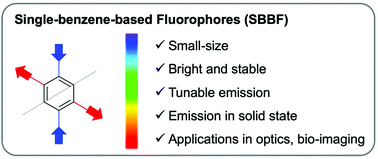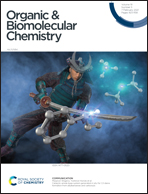Recent advances in single-benzene-based fluorophores: physicochemical properties and applications
Abstract
Fluorescence-based materials and associated techniques (analytical, imaging, and sensing techniques) have been highlighted over the last century throughout various basic research fields and industries. Organic molecule-based fluorophores, in particular, have ushered in a new era in biology and materials science. To date, hundreds of organic fluorophores have been developed, and many studies have introduced new rationales for the fluorophore design and the analysis of the relationship between its structure and photophysical properties both in the solution- and solid-state. In this review, we summarize the recent advances (mainly from 2015 to 2020) in single-benzene-based fluorophores (SBBFs), which have an electron-donor (D)–acceptor (A) type dipolar structure within a compact benzene backbone. We also present a systematic outline of the physicochemical properties of SBBFs and representative examples of their applications, which will provide useful context for the development of new SBBF derivatives in fluorophore-related materials science fields.

- This article is part of the themed collection: Editor’s Collection


 Please wait while we load your content...
Please wait while we load your content...